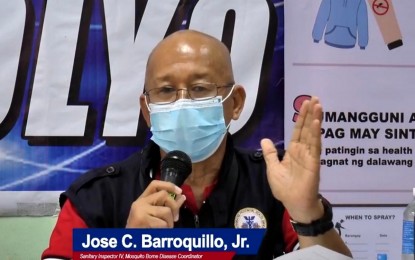
Jose Barroquillo Jr., sanitary inspector of the South Cotabato Integrated Provincial Health Office (File screengrab of live-streamed press conference)
GENERAL SANTOS CITY – Health personnel in South Cotabato intensified their surveillance and case-finding activities against filariasis to keep the province free from the mosquito-borne parasitic disease.
Jose Barroquillo Jr., the sanitary inspector of the Integrated Provincial Health Office, said Wednesday they are continually monitoring at least two remaining barangays that have recorded confirmed cases in the past several years.
He said these are the upland barangays of Maan and Mongocayo in Tboli town, which are among the province’s remotest areas.
The province currently has 33 cases of lymphatic filariasis, also known as elephantiasis, detected in these villages, he said.
“We conduct regular surveillance and case finding activities in these areas to immediately detect possibly new infections and ensure the proper treatment of the patients,” he said in a media forum hosted by the Provincial Information Office.
The Department of Health declared the entire province as filariasis-free in November 2017, the second in Region 12 (Soccsksargen), after the area recorded a nearly zero prevalence rate in a five-year period.
North Cotabato was declared by the agency as the first filariasis-free province in the region in 2011.
Barroquillo said the current cases have not affected the province’s filariasis-free status as it is still below 1 percent of its population.
But he said they need to sustain the disease surveillance and case finding, which is done through blood examination using filaria test strips and nocturnal blood smearing.
He said they subjected the detected cases to immediate treatment and medication through the recommended anti-parasitic drugs.
Advanced stages, especially those already with lymphatic swelling, are subjected to other interventions, including surgery as in the case of a patient from Barangay Mongocayo two years ago.
Barroquillo said they also subject the areas where the cases were detected to mass drug administration covering residents aged two years old and above.
He said they conduct indoor residual spraying in the affected sitios or zones, with the most recent covering 100 households in Sitio Motukling of Mongocayo, to eliminate the mosquito vectors of the disease.
According to the World Health Organization, filariasis is an infection caused by parasitic worms Wuchereria bancrofti, Brugia malayi or B. timori.
These parasites are transmitted to humans through the bite of an infected mosquito and develop into adult worms in the lymphatic vessels, causing severe damage and swelling (lymphoedema).
Elephantiasis, which is exhibited by painful, disfiguring swelling of the legs and genital organs, is a classic sign of late-stage disease.
Baroquillo said filariasis was detected in the previous years in other parts of the province, especially in Koronadal City and the municipalities of Lake Sebu, Tampakan, Tupi, Banga, and Surallah.
He said the disease has since been considered eliminated in these areas following the proper treatment of the patients and intensified disease surveillance. (PNA)
